As an Amazon Associate I earn from qualifying purchases.
When it came time to make an elk stew, my mind immediately went to the Rocky Mountains, home of most of the world’s elk. So this recipe is an ode to the Rockies, from Canada down to New Mexico.

Pretty much every ingredient in this elk stew is something significant to a state or province in or around the Rocky Mountains: green chiles, Great northern beans, wheat berries, porcini mushrooms, greens and root vegetables.
Virtually nothing in it is hard to find — even the porcini, which are in many supermarkets sold dried in little packets. But if you can’t find them, any mushroom will do.
Before I get too far with this recipe, know that while yes, this is an elk stew, there is absolutely no reason this couldn’t be a deer or pronghorn, bison or beef stew. And if you happen to have some Rocky Mountain bighorn sheep, even better!
You’ll notice cold-pressed, extra virgin canola oil in this recipe. Yep, it’s a thing. I first encountered it in Edmonton, Alberta, and was entranced. It is golden, lush and full of flavor. And canola is a really big deal in Alberta.
You can buy cold-pressed canola oil online, but other good options would be sunflower oil or butter.
I use wheat berries here, because wheat is a vital crop throughout the Rocky Mountain region, but they can be hard to find in some places. Use barley in its place if you can’t find wheat berries.
The other quasi-unusual ingredient is Belgian style beer. New Belgium Brewing is in Fort Collins, CO, and I happen to love their beers. So I used a bottle of their Trippel, a very malty, strong ale, in this elk stew. Any Belgian double or trippel would work, and even Blue Moon or Allagash White will do in a pinch. Just nothing hoppy.
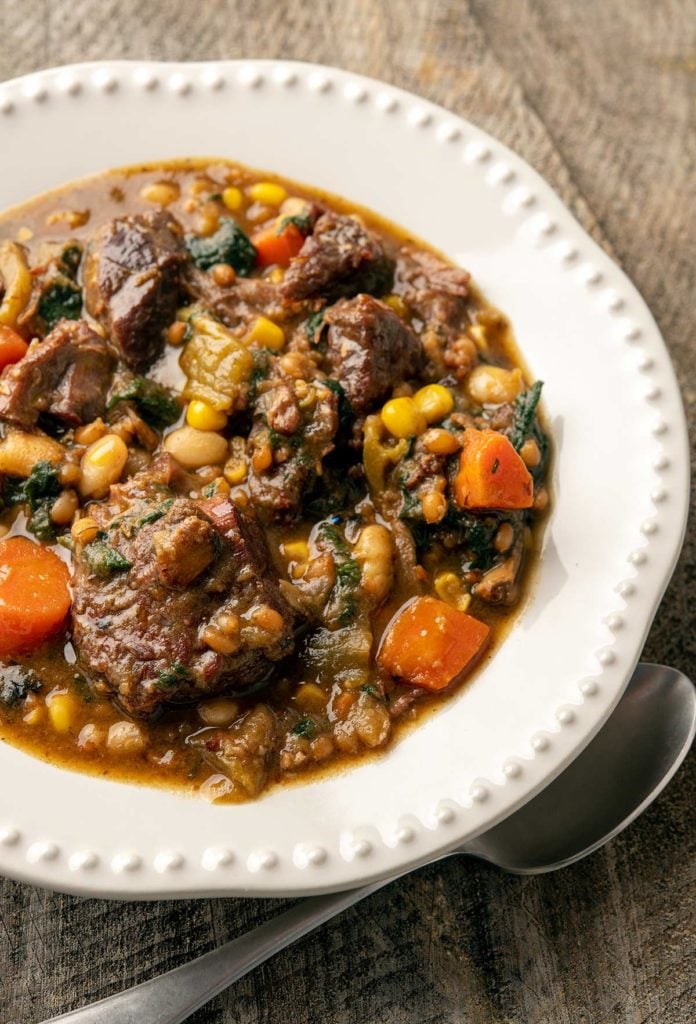
After that, it’s all easy supermarket stuff.
And you can load this stew up with a host of other ingredients important to the Rockies, like sweet corn, Great Northern beans, or chopped greens — I used nettles, which are a common wild green in the mountains.
All this elk stew asks of you is time. Elk meat sometimes takes 3 or more hours to get fall-apart tender, so make sure you have that kind of time. If you have an Instant Pot, cook the stew on high pressure for 35 minutes, then let it release naturally. You can also use a slow cooker, after you have browned the meat and onions.
Once made, this will keep a week in the fridge, and it freezes well.
Looking for other ways to make an elk stew? Try my North African venison stew, A venison stew I designed after all the ingredients in a “food plot” seed mix, or a classic New Mexican green chile stew.
Rocky Mountain Elk Stew
Ingredients
- 4 tablespoons butter, canola oil or sunflower oil
- 2 to 3 pounds elk stew meat
- Salt
- 1/2 cup flour
- 1 large yellow onion, chopped
- 4 cloves garlic, minced
- 1 ounce dried porcini, crushed (or some other dried mushroom)
- 5 Hatch, Anaheim poblano peppers, roasted, seeded, and chopped
- 1 quart elk, venison or beef stock
- 1 pint Belgian beer (anything malty)
- 2 large carrots, peeled and cut unto chunks
- 1 tablespoon fresh sage, minced
OPTIONAL INGREDIENTS
- 1 parsnip, peeled and cut into chunks
- 1 cup corn kernels
- 1 cup cooked barley or wheat berries
- 1 15-ounce can, Great Northern beans
- 1 cup chopped cooked greens, like spinach, nettles, or chard
Instructions
- Heat 2 tablespoons of the butter or oil in a large soup pot with a lid over medium-high heat. Salt the stew meat well, then dust in the flour. Brown the meat in batches, making sure they do not touch each other. Remove the meat to a bowl as it browns and reserve.
- When all the meat is nicely browned, add the remaining oil and the chopped onion. Stir well, and brown this well, too.
- While this is happening, put 2 of the roasted chiles into a blender with the stock and puree.
- Add the garlic and stir to combine. Return the meat to the pot, along with any juices that have collected in the bowl. Pour the contents of the blender into the pot. Crush the dried mushrooms in your hands and add to the pot. Fill the blender bowl again with water and pour that into the pot. Finally, add the beer. Bring all this to a simmer, add salt to taste, partially cover the pot, and let this cook gently.
- If you are using dried beans, wheat berries or barley and greens, now is the time to cook them. If you are using canned beans, wait.
- After about 2 hours, add the carrots and the sage, as well as the parsnip, if using. When they are tender, about 40 minutes or so later, add the remaining green chiles, and any of the other optional ingredients you happen to be using. Taste for salt and black pepper and serve.
Notes
Keys to Success
- I like to use big chunks of neck or front shoulder meat here, sliced across the grain. They look gnarly at first, but after several hours in the pot, that connective tissue melts and you get a really nice stew. Shank chunks work well for this, too.
- Take your time with the browning step for both the meat and onions. This is the foundation of the stew’s flavor.
- This is a place for canned green chiles. I like to roast chiles, but if you don’t, canned will do nicely here.
- If you have the starchy optional things, like the wheat berries and beans, etc. you won’t need anything else. If you skip them, serve this with crusty bread.
Nutrition
Nutrition information is automatically calculated, so should only be used as an approximation.
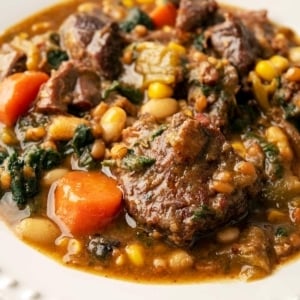
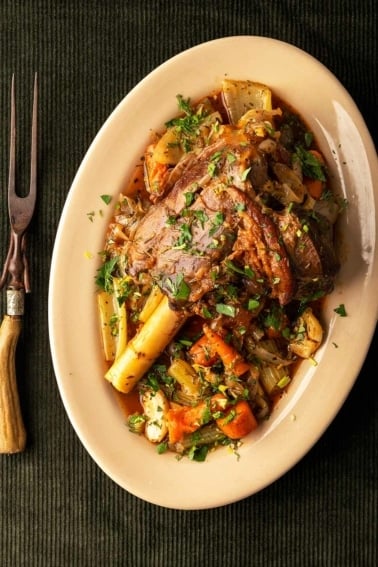
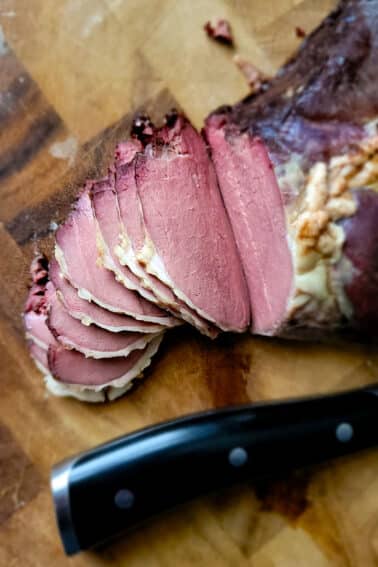

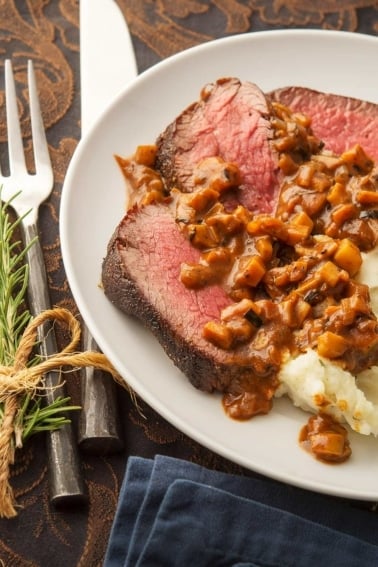
I am in Georgia. My neighbor’s ex-wife gave him some ground elk from Wyoming. He passed it on to me and I looked for recipes and found yours. Even though it was 2-1/2 years old, it smelled goog when I thawed and it tasted good after I browned it. I had to substitute for the region-specific ingredients. All in all, I is awesome. I am on the verge of a food coma. 🙂
.
If I’m using a slow cooker do I add the wheat berries at the start uncooked? And how much fry wheat berries is recommended? Thanks.
Tracy: Hmmm… wheat berries take a while to cook, so yes. I’d highly recommend soaking them overnight before putting them in the slow cooker, too. Pour boiling water over them and let it sit overnight. That will speed things up.
Needs acidity! Add a tablespoon of apple cider!
This sounds awesome I have some elk steak can I use that in the stew?
First time cooking wild neat. Love to eat it , but never cook it. This recipe took me longer than I expected, but was so worth it. Made it for a Métis senior potluck and the Elders loved it!! Thank you.
This is the best stew I believe I have ever had. I put guiness in it instead and chickpeas. Man what a great recipe. Hank Shaw is the bomb!
Thank you very much for sharing this amazing recipe. I had some cooked rice handy, so used that. Also, I like it thickened so added some flour.
What would be your recommendation for thickening?
Rocky Mountain Elk Stew. Got a question. Harvested a great elk last season. I am from Alabama and a stew is soup unless you add potatoes. Would this be a good idea? You have got some great recipes.
Robert: Yes, you can add potatoes if you’d like.
My 16 year old ate every bite, even the kale I added and he hates kale. By far, the best stew I have ever made.
Delicious, full of flavour with just a bit of heat. Wonderful texture. The meat was tender and rich. Highly recommend this dish and will be making it again! Thanks Chef!
Stellar! This is exactly the type of recipe I look for when aiming to enhance the flavors of wild game instead of covering them up (I used Elk. Absolutely delicious!). Thank you Mr. Shaw!
Hank, any recommendations for a gluten free grain to use in place of the barley/wheatberries? Oats, buckwheat, millet, and quinoa are pantry staples for me but I’m curious what you think about their flavor profiles?
Thanks!
Kent: Go for millet. That would be my choice of what you mentioned.
Having just moved to Edmonton, I’m very excited to try this one out!
I made this stew last night. I was short on time so I used my pressure cooker. I brown the elk meat, browned the onions and garlic. Place them in the pressure cooker with the peppers purée, elk bone broth, sage and a little water. Pressure cooked for 20 minutes. Then placed carrots
, quick cook pearl barley and parsnips in the pressure cooker for 5 minutes. Finally, added the corn, beets greens and beans cook them to warm and wilted. The depths of flavors of this stew is incredible. I will definitely make this stew again. Thank you Hank for such a wonderful recipe!
GREAT RECIPE! will have this for Thanksgiving.
Regarding nutrition, what is serving size??
Love all your recipes, adds great variety to my menus.
Thanks in advance,
Mary
Just wanted to thank you for the wonderful recipe Hank, my family is going to really enjoy this throughout the winter months!
“Virtually nothing in it is hard to find” – except the elk!
Gary: Fair. 😎
Hey, Hank…
Great idea for using up the elk in the back of my freezer I forgot about. I wanted to use a slow cooker. What tips would you give (X hours on low, when to add veggies, etc.) for a slow cooker method? Thanks – Brian (from Jersey to CA)
Brian: Sure. 6 to 8 hours on high, add vegetables with about 2 hours to go.
Hi Hank,
That looks good, I may try it with stewing steak one of these winter evenings.
Regards John
Sounds wonderful. How vital are the green ?
When you say now is the time to cook the beans do you mean to add them to the stew to cook? Many thanks. Karen
Karen: The greens are not vital, just a nice touch. And no, I cook dry beans separately usually, but in this case yes, you can add them to the stew because there is nothing overly acidic in it — that will greatly slow the cooking time of any bean.